
- Home
- Memories
- Scrapbook ▽
- Topics ▽
- People ▽
- Events
- Photos
- Site Map
- Timeline
Last update 21st January 2019
Also see
Transports of
delight
Kastners Garage
Standfield and White film from the 1930s
While waiting in one of the frequent queues of traffic, in a city that is increasingly becoming choked with cars, it is interesting to ponder on the beginnings of the motor car in Exeter, more than a hundred years ago.
Nicolaus August Otto was the inventor of the first gas motor engine in 1876. In 1885, the German, Karl Benz designed and built the world's first practical car to be powered by an internal-combustion engine. Of these events, most of the good citizens of Exeter had no notion. However, as early as 1878, the essential fuel for the yet to be introduced horseless carriage could be purchased in Exeter. James E, Rowe & Co were listed as importers of rosaline, petroleum and benzoline oil; at this time such exotic oils were used for lamps, cleaning or medicinal purposes. William Shepherd and Sons, who were engineers, general smiths and boilermakers in Longbrook Terrace were first listed during 1883 as importers of petroleum and benzene, a distillate of petroleum which is better known as petrol. Shepherd and Son would prove to be pioneers of motoring in Exeter during the early years of the new century.
As Exeter rolled towards the new century, awareness that elsewhere in England and abroad there were horseless carriages became known to the local newspapers. In 1896 the 'Red Flag Act' of 1865, restricting road vehicles to four miles an hour in the country, and two miles an hour in town, along with a man walking 60 yards ahead, with a red flag, was repealed. Trewman's Exeter Flying Post reported, in November 1896, the first London to Brighton run that celebrated the repeal of the act. Fifty eight vehicles entered the rally, thirty five started, and twenty five arrived in Brighton.
Although Hoskins claims the first car in Exeter was a Benz in a circus in the Pinhoe Road in 1897, the newspapers reported an incident in 1896 that indicates the appearance of a car in a circus parade in the city even earlier.
Western Times - Wednesday 9th September 1896
MOTOR CAR IN EXETER ACCIDENT. Robert Croaker,", aged 6, living at No. 2, Preston-Street, Exeter, ran after the motor car in the circus procession yesterday, and getting in the way of a horse and cab was knocked down by the animal. He was taken in a cab to the Hospital and detained suffering from broken ribs and injuries to his face and hands.
The circus had been in Exmouth on the 7th, when it was reported "Two horseless carriages–the first to make their appearance in the town – arrived at Exmouth yesterday. They belong to a travelling circus and menagerie and aroused much curiosity."
A case at the Guildhall reported that on 15 July 1898, Ellen Jane Ball had been distracted by a motor-car and found her purse missing a few minutes later. Early in the same year that Ellen Jane Ball was distracted by a car, a Daimler was driven by Mr Sturmey from Lands End to John O'Groats, passing through Exeter, attracting much attention. It was this event that was noticed by William Shepherd our engineer of Longbrook Terrace, who as already mentioned, was an importer of petroleum. Strangely, I have not found a newspaper reference to this momentous occasion. However, this very public demonstration of a horseless carriage must have impressed Mr Shepherd for, by 1899, his firm designed and built its first motor car.
The problems associated with motor cars were highlighted, when the Western Times, in April 1899, reported on a 'four wheeled carriage with a hood' running into difficulties on Fore Street Hill. A more spectacular event took place in December 1900, when Mr Reid, a watchmaker of Sidwell Street was attempting to charge the accumulators of his electric car. A spark caused the vehicle to ignite and a fire ensued. Superintendent Pett and the fire brigade arrived to burst open the door of the building and drag the car outside, before extinguishing the flames. The car was reported as useless and the damage was estimated at £150.
In 1900, the second car to be made in Exeter was a copy of the Benz, built by a Mr Reid - it would seem easier to build your own car than purchase one at this time. In the same year patents were applied for by Frederick Treeby Reid and William Shepperd, for an improved electric generator for use on motor-cars and other engines, and speed gear for starting a car. In 1901, W Shepherd and Son were listed for the first time in Besley's as Motor car manufacturers & Repairers; not that there were many motor cars around to repair.
Another engineering firm, Willey's Foundry, down on Water Lane had become interested in the motor car. Henry Alfred Willey, was an early enthusiast for this novel form of locomotion and had journeyed to Paris during 1902 to purchase a motor car. He then drove the vehicle back to the French coast, had it shipped to Southampton and then driven back to Exeter. He too, remembered Mr Sturmey's brief drive through Exeter, and contacted him about establishing a motor car factory in Exeter. He then had talks with the Coventry Motor Company about the venture; it was planned to manufacture 300 cars per year at a cost of £500 each. However, the start up cost of £47,500 to £65,000 was considered too much to take the project further. H A Willey is also credited with gaining planning permission for the first private garage in the city during 1904.
By this time Shepherd and Son were licensed to store 150 gallons of petroleum spirit, more than any other company in the city. The lone motorist would have to find a works such as Shepherds, or a hardware store to fill up from a can. In 1903, Shepherd's were the first to advertise as selling Petrol for autocars, &c. Not only that, but they were appointed in the same year by the newly formed Automobile Association as an official repairer.
All these cars speeding around at a maximum of 12 miles an hour was sure to tempt some to break the law, to get to their destination faster. The following is the earliest fine I have found for speeding in the city.
Western Times - Friday 18 April 1902
MOTOR CAR PROSECUTION AT EXETER. At the Exeter Police Court yesterday, Leonard Willey, electrical engineer, of 12, Oxford-road, Exeter, was summoned for furiously driving a motor-car down Forestreet on the 12th inst.–P.C. Bradford said he was on duty on Saturday afternoon near St. Olave's Church, when he saw defendant pass him driving a motor-car. At that time he was driving at a moderate rate, but he increased his speed to about 15 miles an hour. This speed he kept up all the way down the hill, slackening a little when he arrived at the bottom. There were several vehicles about at the time.–Blanche Smith, of Alphington, corroborated. –Defendant denied the offence. He estimated the speed down the hill at about six miles an hour. To prove this, defendant said he had speeds on his machine – four, eight, and twelve miles an hour, and he was going less than his second speed. –Miss Theenwisson, a young lady who accompanied defendant in his motor, also denied the offence. –The Bench considered the case proved, and imposed a fine of 10s. and costs.
There were now enough motor cars for the Government to take notice and on 19th November 1903 the Local Government Boards Motor Car (Registration and Licensing) Order became law, requiring all owners to register their vehicle for 20 shillings per year, and require a driving license costing 5 shillings.
Exeter City Council had the job of registering cars in the city from 18th December 1903. FJ was issued to Exeter, based on its position in a list of population sizes of cities and counties. FH was Gloucester, and FK Dudley. Other Exeter prefixes over the years have been CO, DR, DV, JY, OD, TA, TK, TT, UN and UO. The earliest numbers from Devon started with a single T. All the letter combinations were followed by a number 1 to 9999.
FJ was also the first initial of the Mayor, F J Widgery in 1903. Widgery, noticed the coincidence, and claimed in jest, that the regulations had been manipulated in his honour. This, unfortunately, has gained myth like status.
John Evony Norman, of Norman and Pring the brewers, became the first man to register his motor car in the city. He owned a 7hp Benz with a Victoria body in black with red panels – very smart. His registration number was FJ1. By the 31st of December, 9 cars up to FJ9 had been registered, some of which were:
John Norman could also be said to be the cities first petrol head, as judging by the cars he registered up to 1910, he was a real enthusiast. He transferred his FJ1 registered Benz to a 17½ cwt, 12 hp Gladiator, with Tonneau body in dark green on 21st June 1904; this vehicle remained registered until June 1910 as FJ1 and then was re-registered as FJ39. The following were also registered FJ39 in succession; a 7 hp Panhard, registered in August 1905, a 14 hp Gladiator in February 1906, and a 20 hp Bianche in January 1907.
The owner of FJ3, William Budd became the first man in Exeter to allow his daughter to drive. Miss Katherine Rose Budd was also the first woman to take out a driving license on the 25th February 1904. One wonders if she ever faced her dad with a dented wing.
The local elections of May 1904 saw the first motor cars used to run voters to the polling station.
The 25th car was registered on 24th June 1904, just six months after compulsory registration came into force. The breakdown of some vehicle types was - 4 steam, 5 Vauxhalls, 2 own built (one of which was a steam car), a Humber, Peugeot, Clement, Gardiner and Pieper. There were 11 engines of 5 hp or less, 8 of less than 11 hp and 6 of 11 hp or greater. The latter were obviously the boy racers!
The potential value of passing motor traffic became apparent to the Bullers Arms in Alphington Street when they applied for permission to erect a sign saying 'Motor accommodation' - it was approved on 23 March 1904 by the Streets Committee without any comment about drunken drivers!
It took until 9th February 1905 for FJ31 to be reached, and 2nd February 1906 for FJ39, indicating that after an initial surge of interest, sales slowed down.
Motor cars were for the well-to-do and it was the electric tram that took the limelight on Tuesday 4th April 1905, when the Mayor, Councillor Perry drove the first tram along the High Street. The working population could at least travel around the city with some comfort.
Businesses were starting to take note of the new mechanical contraptions on the streets and the coach and carriage works of Messrs Gould Brothers of Southernhay registered their first vehicle, FJ30. A two seater Panhard with racing body was registered to Gould Brothers as FJ40, on 1st September 1905, and sold on 31st October 1905 in one of the first car sales from a dealer in the city. Did the racing body act as a 'babe magnet'.....
Gould Brothers also registered the first taxi to be used for carrying passengers on 1st November 1904. It was in February 1909 that a second hand 16/20 hp Speedwell was purchased as the first privately owned taxi, and in 1911 that the first purpose built taxicab was delivered in Exeter to Arthur Ernest Brock, who took delivery of two machines. Force and Son were the first estate agent to become mechanised when they registered FJ46 so that they could get to their clients more quickly.
W Shepherd and Son were expanding and in their 1905 advert in Besley's they state they are 'Agents for all kinds of Petrol, Lubricating oils, Greases and other requisites for motor cars'. They eventually opened a garage at the top of Longbrook Street, next to the modern King Billy public house. It is reputed to be the site of Exeter's first petrol pump sometime after 1920.
The coach and harness makers of Standfield and White acquired their first vehicle, a 16 hp Napier in April 1906, which was registered to Sebastian White. Besley's from the same year lists Standfield & White as coachbuilders, motor car, saddle and harness makers. They would become one of the most prominent, and long lasting, garages and car dealerships in the city, from their Sidwell Street premises. Palmer and Edwards the bakers, who would later become Hill Palmer and Edwards, registered Exeter's first bread delivery van, a 8 hp Wolseley on 29th May 1906.
A survey in 1908 was made of vehicles in the High Street, and up to thirty vehicles an hour were counted going about their business.
FJ100 was reached in 1909 and FJ125 in 1910 - I bet the locals were already complaining about traffic jams in the High Street. The old, established firm of Green and Son that would become Bobbys and then Debenhams, took delivery of their first van, a 20 hp Ford in black and brown, on 9th February 1912. The first petrol driven fire-engine was delivered to the city fire service in January 1914 - a Merry Weather Ltd appliance FJ450, named Exonia, it was used to tow the, formerly horse drawn, steam fire-pump Devonia that dated from 1897.
At the outbreak of the First World War, and the Flying Post reported that 'the steam lorries of a city brewery and another firm were also taken by the military'. The wartime period saw a drop in registrations in Exeter.
In 1916, Miss Morrison, who lived in Taddiford House, was a renowned eccentric, gambler and keeper of wolf hounds. She was an early motoring enthusiast, who allegedly won the Paris Grand Prix in 1914, although I have found no reference to it. She is reputed to have driven her Mercedes around Exeter during 1916, despite employing a chauffeur, whose real job was to polish the car - can't trust a male driver.
The first car to be registered after the Armistice was FJ898, sixteen days after the cease fire, on the 27th November 1918. Since the end of the First War, the motor car has taken a firm grip upon the nation - when I learned to drive there were perhaps 18 million vehicles on Britain's roads. Forty years later and there are 30 million. From an eccentric plaything for the rich, the plaything has become a choking, climate changer which controls the people rather than the reverse.
So, the next time you are sitting in a traffic queue in the Topsham Road, or waiting to cross the giant roundabout of the twin bridges, spare a thought for the pioneers of motoring in Exeter, and what they would make of the growth of modern motoring.
Sources: TwoThousand Years in Exeter by W G Hoskins, Exeter City Council Minutes, the City Council Motor Vehicle Registration Records from 1903 onwards, Besley's and Kelly's Directories, The Express and Echo, Trewman's Exeter Flying Post, Victorian Exeter by Robert Newton, Hazel Harvey and the Mercedes Benz website.
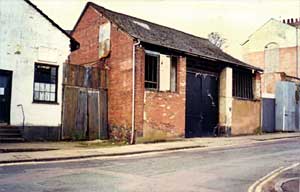 Exeter's first garage, W Shepherd's, Albion Foundry. Photo Aubone
Braddon.
Exeter's first garage, W Shepherd's, Albion Foundry. Photo Aubone
Braddon.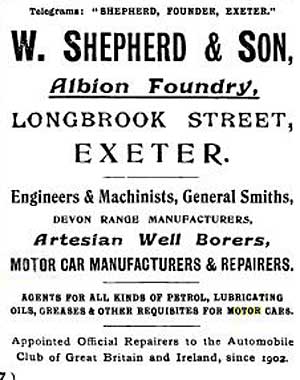 A 1906 advert for W Shepherd and Son.
A 1906 advert for W Shepherd and Son.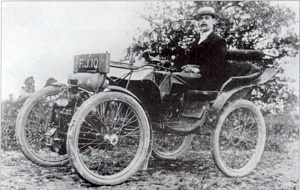 FJ10 was a de Dion Bouton owned by Exeter printer Albert Cannicott.
FJ10 was a de Dion Bouton owned by Exeter printer Albert Cannicott.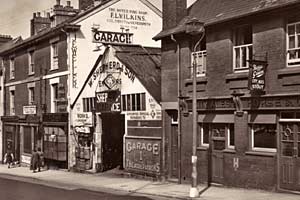 The site, in Longbrook Street, of Exeter's first petrol pump installed
about 1920. Pictured in the 1940's, it was run by W Shepherd and Son.
The building was demolished in 2007. The Horse and Groom pub, next
door, is now King Billy's.
The site, in Longbrook Street, of Exeter's first petrol pump installed
about 1920. Pictured in the 1940's, it was run by W Shepherd and Son.
The building was demolished in 2007. The Horse and Groom pub, next
door, is now King Billy's.
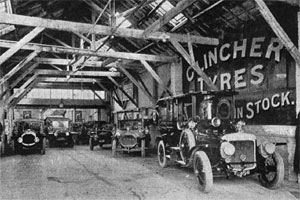 The
Standfield and White workshop, circa 1912
The
Standfield and White workshop, circa 1912
The first registrations for a .....
Vauxhall - FJ3 on 22 December 1903
Peugeot - FJ14 on 26th February
1904
Wolseley - FJ18 on 6th April
1904
Rover - FJ31 on 9th February
1905
Humber - FJ35 on 5th May 1905
Austin - FJ96 on 22nd December
1908
Fiat - FJ104 on 1st June 1909
(allegedly 50hp)
Ford - FJ161 on 4th January
1911 (Model T)
Renault - FJ173 on
26th November 1910
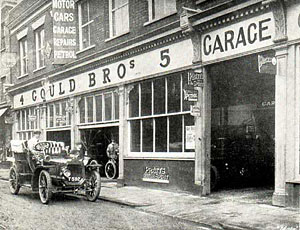 Gould
Brothers, circa 1912.
Gould
Brothers, circa 1912.
Gould Bros. Advert from
April 1906
The company offered the
following.....
Special Bargains this week
15 hp MINERVA, three
cyclinders, perfect order; lamps, tools, and spares, three-seated
Tonneau. £175
7-10 hp PANHARD, two cylinders,
Kreb's carburetter, wheel control, cape hood, wind shield, side doors,
as new, £275.
6 hp HUMBER, three speeds and
reverse, very little used, £120
6 hp BABY PEUGEOT, latest type,
fast, good hill climber, £175
5 hp VAUXHALL, good order,
tools and spares, £45
1906 CARS - Darracqs,
Wolseleys, De Dions, Humbers. Early deliveries.
Your old Car or Carriage taken in
part exchange.
I wonder if they still have the Peugeot.....
Motoring Trivia
• In
1934, FJ8300 was the first police van to be registered in the
city.
• By 1914, 577 driving licenses had been issued.
• By 1960, 15,000 motor
vehicles were registered in Exeter.
• By 1920, 1,300 driving
licenses had been issued in Exeter.
• In 1961/2 the Devon
Constabulary took delivery of two Austin
Healey 3000s. They were supplied by Pikes of Exeter.
• The
first petrol pump is thought to have been at the top of
Longbrook Street.
• The largest car registered in 1910 was a 5
seater weighing
22¼cwt.
• The Anglo-American Oil Company Ltd applied for
permission to
store 5000 gallons of petrol in an outhouse built of corrugated iron in
a field on Cowley Bridge Road in 1906.
• Sidney Philip Pike ran
a confectioner and refreshment house in
1912.
• The St Thomas Motor Cycle and Cycle Car Garage,
Alphington
Street, proprietor Phillip Pike had its first listing in 1914 Besley's.
• P Pike and Co Ltd, appeared for the first time in Kelly's 1919.
• Devon County Council early registrations started with a T.
• Exeter lost the right to
license motor vehicles in 1972 when
Devon County Council took over the function. FJ was absorbed into
Devons range of 3 letter registration letters.
• The New London Inn converted
their stables into garages for 50 vehicles in 1907.
 Maudes Garage, New
North Rd in the early 1930's.
Maudes Garage, New
North Rd in the early 1930's.
Photo and information supplied by Kevin Peters.
 Early
petrol pumps in Exeter Left - Water Lane, Right - Exwick -
photos by Alan Mazonowicz.
Early
petrol pumps in Exeter Left - Water Lane, Right - Exwick -
photos by Alan Mazonowicz.
│ Top of Page │